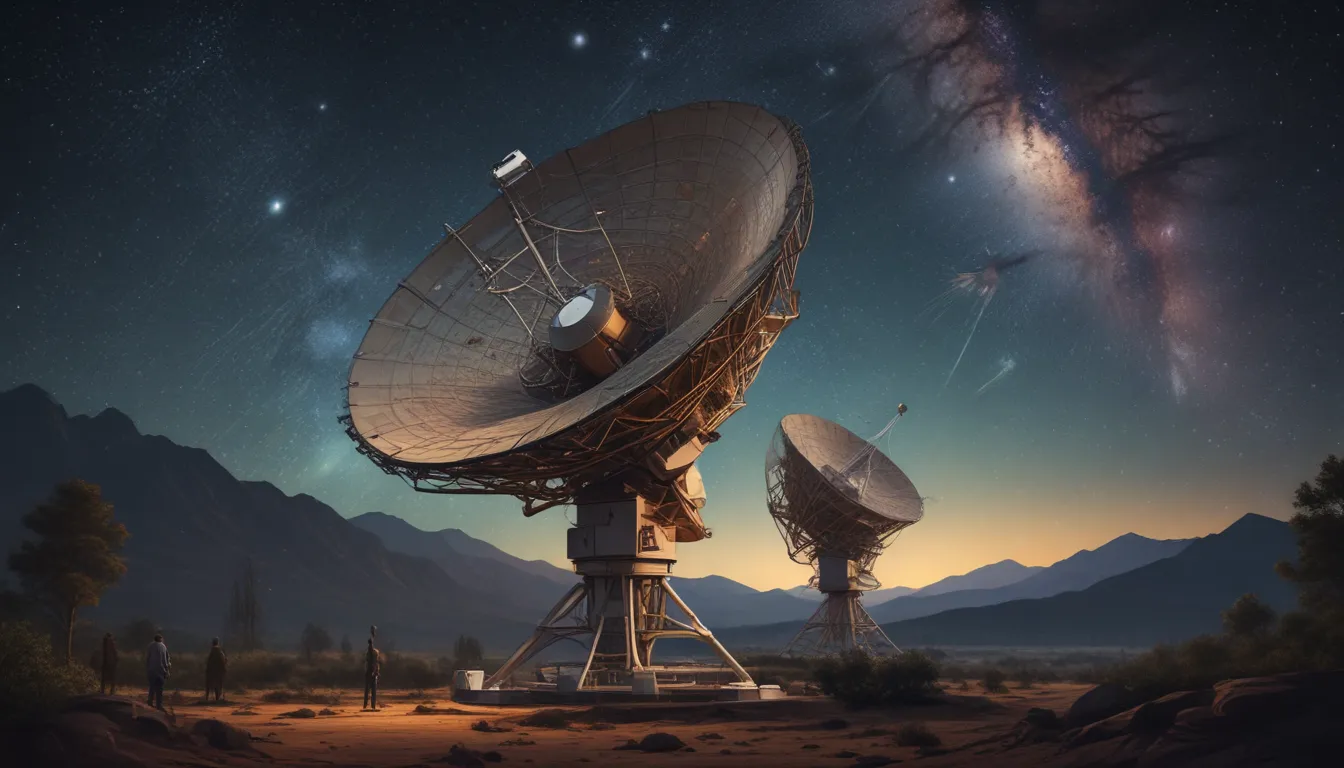The pictures we use in our articles might not show exactly what the words say. We choose these pictures to make you interested in reading more. The pictures work together with the words but don’t take their place. The words still tell you the important facts.
Radio astronomy is a captivating field that allows us to peer into the mysteries of the universe using radio waves. Through advanced technology and powerful telescopes, scientists have made remarkable discoveries that have transformed our understanding of the cosmos. In this article, we will delve into the world of radio astronomy and unveil 15 astounding facts that showcase the incredible achievements in this field. From the accidental discovery of cosmic microwave background radiation to the detection of pulsars, radio astronomy has revolutionized our knowledge of celestial objects and phenomena. Join us on a mind-blowing journey through space and time as we explore the wonders of radio astronomy!
Exploring the Depths of the Universe
- Radio astronomy has led to groundbreaking discoveries, such as the accidental finding of cosmic microwave background radiation, supporting the Big Bang theory and revolutionizing our understanding of the universe’s origins.
- By using radio telescopes, scientists can study everything from black holes and cosmic rays to exoplanets, offering a unique perspective on the universe and potentially finding habitable exoplanets.
Discoveries that Shaped Our Universe
Discovery of the Cosmic Microwave Background Radiation
In 1964, Arno Penzias and Robert Wilson stumbled upon the cosmic microwave background radiation, providing compelling evidence for the Big Bang theory.
Largest Single-Dish Radio Telescope
The Arecibo Observatory in Puerto Rico, with its massive 305-meter diameter, stood as the world's largest single-dish radio telescope until its recent closure. It played a vital role in numerous radio astronomy discoveries.
Unveiling Celestial Mysteries
Pulsars: Lighthouses of the Universe
Pulsars, rapidly spinning neutron stars that emit regular beams of radio waves, serve as highly accurate cosmic clocks that have been used to test Einstein’s theory of general relativity.
Search for Extraterrestrial Intelligence (SETI)
Radio astronomers have been actively engaged in the search for extraterrestrial intelligence by scanning the sky for artificial radio signals. The transmission of the Arecibo Message in 1974 aimed to establish contact with intelligent beings.
Unraveling the Universe’s Secrets
Radio Galaxies and Quasars
Radio astronomy has unveiled the existence of powerful galaxies known as radio galaxies and their energetic counterparts, quasars, shedding light on the early stages of the universe.
Mapping the Hydrogen Gas in the Universe
Utilizing radio telescopes, astronomers can map the distribution of hydrogen gas, the most abundant element in the universe, offering valuable insights into the structure and evolution of galaxies.
Delving into Cosmic Mysteries
Cosmic Magnetism
Radio astronomy enables the study of cosmic magnetism, vital for understanding the formation of stars, galaxies, and the overall structure of the universe.
Radio Interferometry
The technique of radio interferometry, which combines multiple radio telescopes to create a virtual telescope with high resolution, has revolutionized our understanding of celestial objects.
Glimpses of Our Solar System
Studying the Solar System
Radio astronomy allows for the study of various objects in our solar system, including the Sun, planets, moons, and asteroids, providing insights into their composition, geological processes, and atmospheres.
Cosmic Microwave Background Radiation
The cosmic microwave background radiation, the afterglow of the Big Bang, has been studied by radio astronomers to better understand the early universe and galaxy formation.
Mysteries of the Universe
Fast Radio Bursts
Fast radio bursts (FRBs), intense bursts of radio waves with unknown origins, continue to puzzle scientists and spark intriguing speculations due to their fleeting nature.
Radio Telescopes in Space
Some radio telescopes are placed in space to avoid atmospheric interference. Space-based telescopes like the Hubble Space Telescope and the upcoming James Webb Space Telescope offer radio capabilities for observing the universe beyond Earth.
Probing the Depths of Space
Radio Astronomy and Black Holes
Radio observations have been instrumental in the detection and study of black holes, allowing scientists to explore the properties of these enigmatic cosmic entities.
Cosmic Ray Detection
Radio telescopes can detect cosmic rays, high-energy particles originating from various astrophysical sources, offering insights into the violent processes in the universe.
Seeking Life Beyond Earth
Exploring Exoplanets through Radio Waves
Radio waves emitted by exoplanets and their surroundings provide crucial information about these distant worlds, offering a unique perspective in the search for habitable exoplanets.
Conclusion: Embracing the Cosmos
Radio astronomy opens up a realm of wonders, from distant galaxies to enigmatic pulsars, enriching our understanding of the universe. The 15 astounding facts about radio astronomy showcased in this article underscore the exceptional capabilities and achievements of this scientific discipline.
As technology advances, radio astronomers can delve even deeper into the cosmos, revealing more awe-inspiring phenomena. With ongoing research and discoveries, the future of radio astronomy promises to unveil further secrets of the universe. Look up at the night sky and know that a world of wonders awaits exploration through the remarkable science of radio astronomy.
FAQs: Exploring the Universe
-
What is radio astronomy?
Radio astronomy is a branch of astronomy focused on studying celestial objects and phenomena using radio waves, detected and analyzed through specialized radio telescopes. -
How does radio astronomy work?
Radio astronomy involves collecting radio waves emitted by celestial objects, converting them into electrical signals through radio telescopes, and analyzing the data to extract valuable scientific insights. -
What can we learn from radio astronomy?
Through radio astronomy, we gain insights into the formation and evolution of galaxies, the existence of pulsars and quasars, the cosmic microwave background radiation, and the detection of exoplanets. -
How do radio telescopes differ from optical telescopes?
Radio telescopes detect radio waves rather than visible light, capturing longer wavelength signals that provide unique perspectives on the universe compared to optical observations. -
What significant discoveries have been made through radio astronomy?
Radio astronomy has led to significant discoveries, including the detection of pulsars, the first observation of cosmic microwave background radiation, and the confirmation of Einstein's theory of general relativity through gravitational wave observations. -
Can anyone become a radio astronomer?
While becoming a professional radio astronomer usually requires extensive education and training, amateur radio astronomy is accessible as a hobby, with various resources and amateur astronomy groups available for enthusiasts.
Radio astronomy continues to unveil groundbreaking discoveries, sparking curiosity and fascination with the wonders of the universe. Explore the marvels of space-based radio astronomy and delve into the pioneering contributions of Karl Jansky, whose work laid the foundation for this incredible science.
Was this information helpful?
Our dedication to delivering trustworthy and engaging content drives our work. Each fact on our site is contributed by users like you, ensuring a wealth of diverse insights and information. With dedicated editors reviewing each submission, we uphold the highest standards of accuracy and reliability, guaranteeing fascinating and credible facts for our readers. Trust in our longstanding commitment to quality and authenticity as you embark on a journey of exploration and learning with us.






